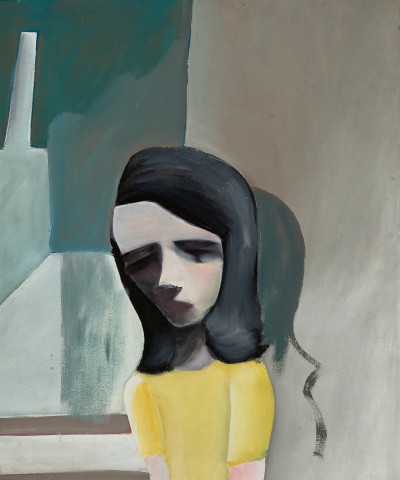BARBARA, c.1960
CHARLES BLACKMAN
oil on cardboard
75.0 x 62.5 cm
signed lower left: Blackman
Private collection
Sotheby’s, Melbourne, 25 August 1998, lot 23
The Cbus Collection of Australian Art, Melbourne, acquired from the above
Figurative Works from the Cbus Collection, Latrobe Regional Gallery, Victoria, 4 August – 2 December 2012
on long term loan to Bendigo Art Gallery, Victoria
Nainby, B., Stanhope, Z., and Furlonger, K., The Cbus Collection of Australian Art, in association with Latrobe Regional Gallery, Melbourne, 2009, pp. 15, 98 (illus.), 213
Charles Blackman met his future wife, poet Barbara Patterson in 1948 and after an ‘unofficial’ wedding on Sydney’s Dee Why Beach in 1950, they were legally married in Melbourne in 1951.1 Working as a life model to supplement their income and to enable Blackman to paint full-time, Barbara’s domestic proximity meant that Blackman had a skilled and readily available model at home, and it is not surprising that she became a source of inspiration and a constant presence in his work throughout the 1950s and 60s. However, as Barbara recalled, theirs was not a conventional artist-model relationship: ‘Husband Charles never drew me as posed nude. In the late fifties he was invited to contribute to an exhibition of nude work. He asked if drawing a baby without clothes was eligible.’2
Barbara was declared legally blind in 1950, and as her sight deteriorated, Blackman was increasingly drawn into the world of words and literature by reading aloud to her. Blackman first encountered Lewis Carroll’s Alice in Wonderland (1865) as a talking book on Barbara’s new talking book machine, resulting in the artist’s celebrated Alice in Wonderland series of 1956 – 57. Full of distortions of scale and physical space, the couple appear in the series as Carroll’s key players, with Barbara as Alice and Charles as the White Rabbit. As Felicity St John Moore has observed: ‘Listening to the story again and again, he was struck by the parallels between the fabulous Alice and the real Barbara, including her distorting body image (their first child was born as the series came to an end) and her increasing spatial disorientation to which they were both then trying to adjust.’3
The images that followed the completion of Blackman’s Alice series comprised paintings of family intimacy and blindness, and of mother and child (the couple’s first son, Auguste, was born in 1957), worked from both formally posed and family photographs. Barbara, c.1960 is a poetic and slightly melancholic portrait, with the subject’s sightless eyes and features obscured by darkness; her shadow implying a sense of psychological separation as it reflects on the wall behind her, seemingly independent from the form of her body. As Blackman explained: ‘My sort of painting isn’t sparked off directly by visual things, although … its point of reference is visual. It’s sparked off by what I feel about something perhaps in a book. And I suppose it’s got to do with the fact that Barbara and I have been related pretty successfully as people, because I go into her world to a degree.’4
Barbara’s isolation from the city beyond the window at which she stands is also made palpable by the painting’s sombre blocks of colour, which sit in stark contrast to her bright yellow top; perhaps signifying the role she plays in the artist’s life and what she brings to his world and art personally and intellectually.
1. St John Moore, F., Charles Blackman: Schoolgirls and Angels, National Gallery of Victoria, Melbourne, 1993, p. 16
2. Blackman, B., Glass After Glass: Autobiographical Reflections, Penguin Books, Ringwood, 1997, p. 167
3. St John Moore, op. cit., p. 4
4. Ibid.
KELLY GELLATLY
